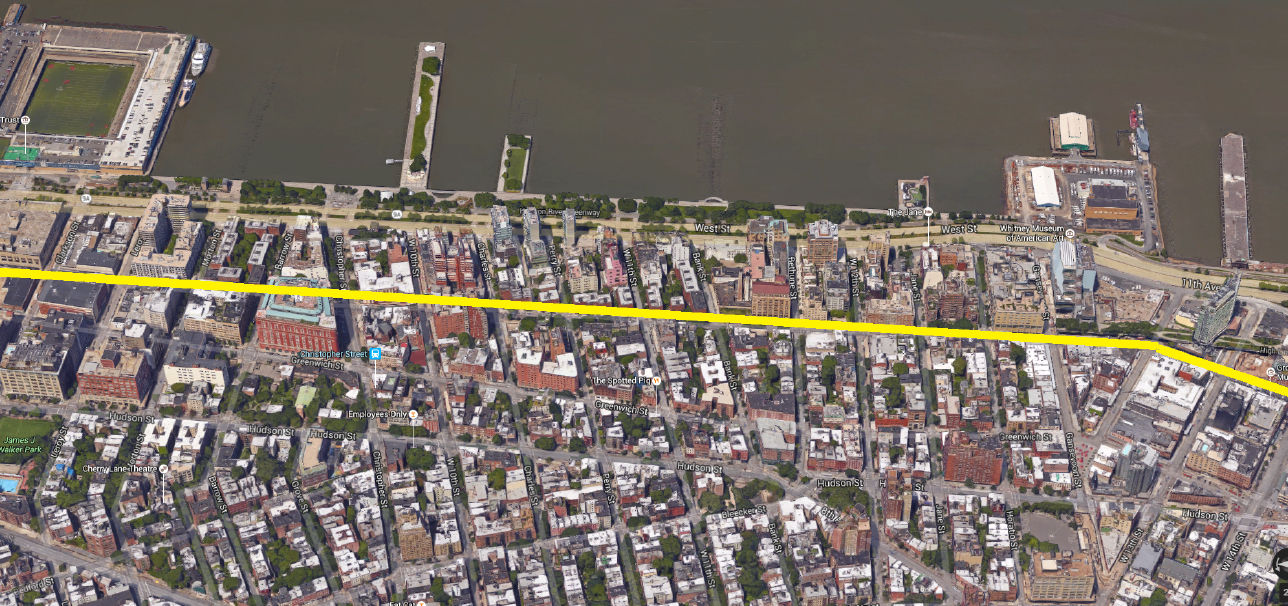The Battle Over Hudson River Park’s Air Rights
On July 18, 2013, Village Preservation publicly signaled the alarm over legislation passed in Albany with little community input but with massive potential impact for the West Village and communities on the west side of Manhattan. That legislation would have allowed the transfer of as much as approximately 1.6 million sq ft of unused air rights from Hudson River Park commercial piers (where development was allowed) to one block inland, in the neighborhood, along and adjacent to West Street. While the intent of the new law may have been in part to provide a new source of funding for the park, the transfer could have resulted in a good deal of rezoning and out-of-scale construction in our neighborhoods.

At the very least, Village Preservation Executive Director Andrew Berman wrote that day in The Villager, the legislation “may facilitate substantially larger development on the blocks bounded on the west by West St., all the way from Chambers St. to 59th St. Worse, it may open the door to, and provide an incentive and rationale for, rezoning parts of our neighborhood to permit even larger development than just the air-rights transfers, in themselves, would allow. And it is yet another step toward requiring real estate development as the price for securing public amenities and infrastructure — a disturbing trend which has become increasingly common in New York City in recent years.”
To give some perspective, 1.6 million sq ft would be equal to eight of NYU’s Silver Towers buildings — 30 stories tall, each 200,000 sq ft — being built along West Street.
In 2015, New York City announced an agreement with a developer and the Hudson River Park Trust for a massive rezoning plan at the three-block St. John’s Terminal site (bounded by West, Clarkson, and Washington Streets, extending two blocks south of Houston Street). At the time, the site was zoned for 1 million square feet of space with no height limit, limited to commercial uses (office, hotel, retail). Under the city’s plan, much more lucrative residential uses would be allowed, and the size of allowable development would increase by about 70%, or 810,000 sq ft. As part of the plan, $100 million would be paid for 200,000 sq ft of air rights from Pier 40, which would go towards repairing the public pier.

Fortunately, the community spoke up in response to this plan. Village Preservation worked with other local organizations to develop alternatives to the state legislation and the city’s proposal. Thousands of people spoke up via letters and emails, at community board hearings, and at town hall meetings. With the support of Community Board 2 and then–City Councilmember Corey Johnson, a new plan was unveiled in late 2016. The outcome from a neighborhood preservation perspective was “about as good as anyone could hope for,” Andrew Berman wrote in an opinion piece for amNY.
To start, the city agreed to designate the third and final phase of our proposed South Village Historic District. The Sullivan Thompson Historic District, as the area was called, protected a 10-block, low-rise area from inappropriate demolition and out-of-scale development.
In addition, strict limits were placed on the transfer of air rights from Hudson River Park to the area within Community Board 2, from 14th Street to Canal Street; the idea of moving 1.6 million sq ft to develop West Street–based high-rises was no more. Only the air rights from Pier 40 would be sold to repair that site and other infrastructure within the park. Lastly, there would no longer be any big-box stores allowed in the St. John’s development, limiting traffic impacts on the community.
This was a huge victory for the causes of preservation and responsible development, all made possible because people spoke up and made their voices heard. You can learn more about our and your efforts toward this win on our website.
